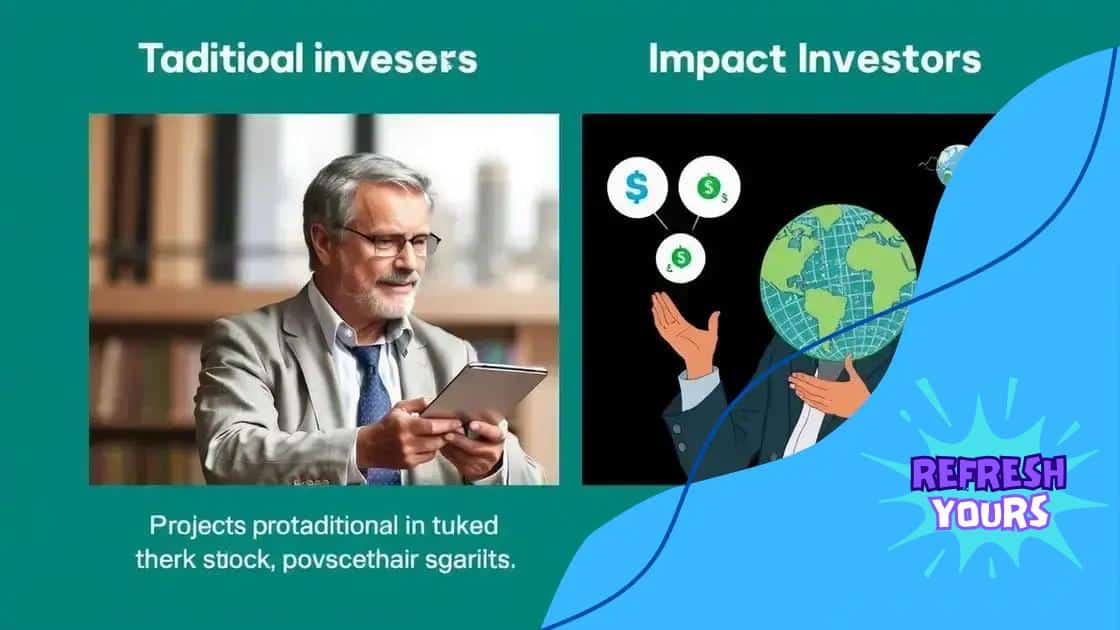Impact investing: How it’s transforming finance today

Impact investing combines financial returns with positive social and environmental impact, utilizing strategies like renewable energy investment, green bonds, and ESG integration to drive sustainable growth.
Impact investing is reshaping the finance landscape as investors seek to generate social and environmental impact alongside financial returns. Have you wondered how this innovative approach can influence your investment decisions?
Understanding impact investing
Understanding impact investing is essential for anyone looking to make a positive change while generating financial returns. This approach focuses on investing in projects and companies that offer measurable social and environmental benefits.
Let’s explore some of the key principles that define impact investing.
Key Principles of Impact Investing
At its core, impact investing is about creating a tangible impact. It is not merely about seeking profit but ensuring that the investments contribute to society. Here are a few principles:
- Intentionality: The investor aims to create positive social or environmental effects.
- Financial Returns: While social impact is the focus, financial returns are still important.
- Measurement: Impact must be measured to understand the effects and improve future investments.
These principles guide individuals and organizations in making informed decisions about their investments.
Another crucial aspect of understanding impact investing is recognizing its differences from traditional investing. In traditional finance, the primary goal is maximization of profit without consideration for social or environmental implications. In contrast, impact investing strives for a balance between profit and positive change.
Investors are encouraged to look at their priorities. Some might focus more on the social impact, while others might prioritize their financial returns. The beauty of impact investing is that it allows for flexibility, enabling individuals to tailor their investments according to their values.
As we dive deeper, it’s important to grasp how impact investing can take various forms. From investing in renewable energy to supporting companies that promote fair trade, the opportunities are vast.
Strategies for Sustainable Impact Investing
When looking into impact investing, you might consider different strategies.
- Direct Investments: Funding specific projects or startups that align with your values.
- Funds: Investing in funds that specifically focus on impact-driven ventures.
- Community Investments: Putting money into local or underserved communities to foster growth.
Understanding these options can enhance your ability to invest wisely and meaningfully. Each strategy offers distinct pathways to achieve both a financial return and a positive impact.
Furthermore, impact investing is growing rapidly, which shows its increasing relevance in today’s financial world. Investors are more aware than ever of their potential to influence societal issues through their investment choices.
Overall, as we progress through this article, keep in mind how impact investing represents a shift in the paradigm of finance. It invites individuals to take accountability for their investments and fosters a culture of responsibility in the financial sector.
Key principles of impact investing
The key principles of impact investing serve as the foundation for how investors approach their financial choices. Understanding these principles can help investors align their financial goals with broader social values. Each principle guides investors toward making meaningful impacts.
Intentional Investment
One of the main principles is intentionality. Investors must actively seek opportunities that promise positive social and environmental results. This means going beyond the desire for profit and choosing investments that support a greater purpose.
Financial Returns
While social impact is essential, investors also expect reasonable financial returns. This principle highlights the balance between making a profit and creating change. Success in impact investing lies in finding opportunities that yield both.
- Targeting sectors: Focus on industries that generate significant social benefits, like renewable energy or education.
- Portfolio diversification: Balance high-impact investments with traditional assets to ensure stable returns.
- Long-term perspective: Assess potential over years rather than focusing on quick gains.
As investors apply these principles, they often look at potential impacts. Understanding metrics is vital to evaluate how investments perform against expectations. This helps ensure that their money is making the desired difference.
Another critical principle is measurable impact. Investors need to establish how they will measure the outcomes of their investments. This transparency fosters trust and drives further investment into areas that show promising results. Measurement also helps refine strategies for future investments.
Additionally, investors should think about collaboration with stakeholders. Engaging with communities, non-profits, and other investors creates a network that enhances impact. Working together allows for pooling resources and knowledge, which amplifies the overall effect of the investments.
By adhering to these key principles, impact investors can pave the way for a new financial landscape that prioritizes societal benefits along with traditional returns. This approach invites more individuals to consider how their investments can create a positive ripple effect in the world.
How impact investing differs from traditional investing

Understanding how impact investing differs from traditional investing is vital for anyone interested in making informed financial decisions. While both approaches aim to generate returns, their underlying principles and goals vary significantly.
Traditional investing primarily focuses on maximizing financial profits. Investors seek the highest return on their investment by selecting stocks, bonds, or other assets based on their potential for growth. Therefore, the trade-offs are often made with little regard for social or environmental consequences.
Emphasis on Social Impact
In contrast, impact investing integrates a commitment to social and environmental impact into its core philosophy. Investors not only want financial gain but also aspire to create a positive change in society. This intentionality is what sets impact investing apart.
Measurement of Results
Another crucial difference lies in how results are measured. Traditional investors look primarily at financial statements, focusing on profit margins, returns, and growth rates. Impact investors, however, consider both financial performance and the tangible outcomes of their investments, such as reduced carbon emissions or improved community health.
- Data analysis: Impact investing demands rigorous analysis of both financial and social metrics.
- Verifying impact: Investors often use third-party evaluations to confirm their impact.
- Long-term vision: Focus is typically on sustainable success, rather than short-term gains.
Moreover, traditional investors may not actively engage with the companies they invest in. They often take a hands-off approach, while impact investors frequently seek to work closely with their investments. This collaboration can enhance both the financial viability and the social mission of the projects or companies involved.
Additionally, the types of assets invested in can vary greatly. Traditional investing often remains within conventional markets, while impact investing opens doors to various sectors like renewable energy, affordable housing, and education. This variety allows investors to align their portfolios not just with their financial goals, but also with their personal values and beliefs.
Overall, the distinctions between these two investment strategies are clear. While traditional investing prioritizes profits alone, impact investing seeks to balance financial success with meaningful change. This represents a shift in how many investors view their role in the economy.
Impact investing strategies for sustainability
Exploring impact investing strategies for sustainability is crucial for those who want to make a meaningful difference while earning returns. These strategies focus on generating positive outcomes for the environment and society alongside financial gains.
One effective approach is to invest in renewable energy projects. These projects not only help in reducing reliance on fossil fuels but also create jobs and promote cleaner air. Investors are increasingly recognizing that sustainable energy investments can yield substantial financial returns while addressing environmental challenges.
Green Bonds
Another strategy is utilizing green bonds. These are bonds specifically issued to fund projects with positive environmental impacts. Popular projects include energy efficiency initiatives and sustainable agriculture. Green bonds provide a reliable income stream and are a way to support essential environmental goals.
Impact-focused Equity Investments
Impact-focused equity investments involve backing companies dedicated to social and environmental change. By investing in these companies, shareholders can directly contribute to positive changes while benefiting from potential stock price appreciation.
- Sector focus: Prioritize sectors like clean technology or sustainable agriculture.
- Community engagement: Seek out businesses that empower local communities.
- Long-term partnerships: Work with organizations committed to sustainability.
Another important strategy is to consider funds that focus specifically on sustainable investments. These funds pool capital to invest in a diversified range of sustainable companies. They offer a way to invest in various sectors without needing to research each company individually.
Additionally, involving stakeholders is vital. Impact investors should collaborate with communities and organization leaders to understand their needs better. Engaging with stakeholders ensures that investments align with local priorities and provides a feedback mechanism to improve project outcomes.
Overall, employing diverse impact investing strategies fosters sustainability. Investors can harness financial power to drive change in the world while benefiting from promising returns.
Future trends in impact investing
The future trends in impact investing reveal a growing movement towards sustainable finance. Investors are increasingly recognizing the value of aligning their financial goals with social and environmental impact. This shift reflects a broader awareness of global challenges, such as climate change and inequality.
One significant trend is the rise of technology in impact investing. Platforms that connect investors with impact projects are becoming more prevalent. These platforms streamline the investment process, making it easier for individuals and organizations to identify and engage with opportunities that match their values.
Integration of ESG Factors
Another key trend is the integration of Environmental, Social, and Governance (ESG) factors into investment decision-making. Investors are looking beyond financial returns to assess the sustainability and ethical implications of their investments. This holistic view supports informed decisions that can lead to greater positive outcomes.
Collaborative Approaches
Collaboration will also play a vital role as more stakeholders come together to address social challenges. Partnerships between private investors, governments, and non-profit organizations will lead to innovative solutions and enhance the impact of investments.
- Public-Private Partnerships: Collaborations that leverage resources and expertise from both sectors.
- Shared Value Initiatives: Projects designed to create economic value alongside social benefits.
- Community Investments: Engaging local communities to identify needs and project potential.
Moreover, as millennials and Gen Z become more prominent in the investment landscape, their preferences will drive changes. These generations place a strong emphasis on social activism and prefer investments that reflect their values. This shift towards ethical investing indicates that companies will need to adapt to attract these new investors.
Lastly, measurable impact will continue to gain importance. Investors will demand transparency regarding the outcomes of their investments. This push for accountability will drive innovations in how impact is measured and reported, leading to more standardized metrics in the field.
Overall, the future of impact investing is bright. As more people recognize the potential of their capital to create change, the landscape will continue to evolve, emphasizing a blend of profitability and purpose.
FAQ – Frequently Asked Questions about Impact Investing
What is impact investing?
Impact investing refers to investments made with the intention of generating positive social and environmental impact alongside a financial return.
How does impact investing differ from traditional investing?
Unlike traditional investing, which focuses solely on financial returns, impact investing prioritizes both financial gain and measurable positive impact.
What are some common strategies used in impact investing?
Common strategies include investing in renewable energy, utilizing green bonds, and supporting companies that focus on social and environmental sustainability.
Why is technology important in impact investing?
Technology plays a crucial role by connecting investors to impact projects, making the investment process more efficient and accessible.





